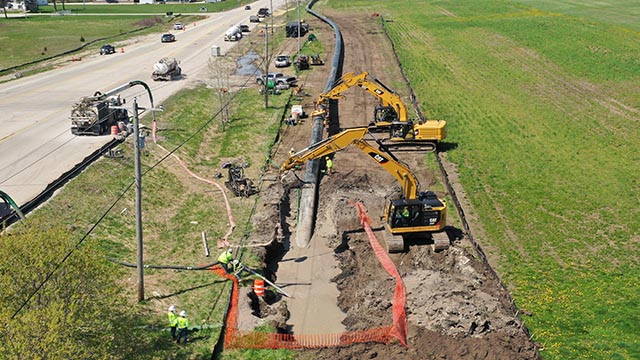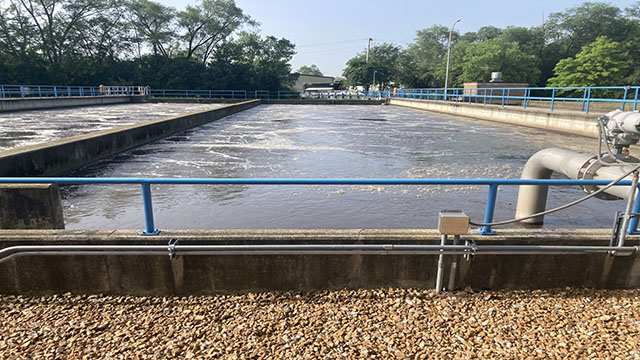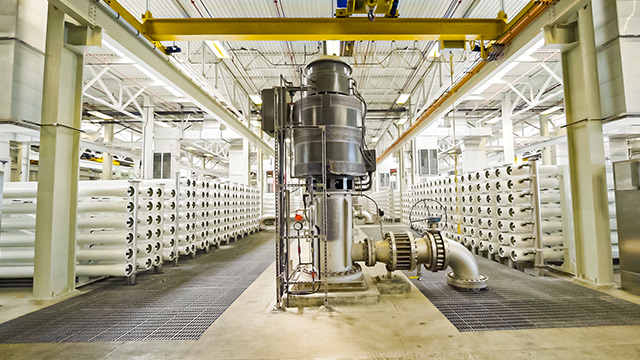Cities develop around rivers, their water necessary for society and commerce to thrive. On the flip side, to endure, their flood risks must be mitigated. That has been the case for eons yet managing wet weather flows is more complex and challenging than ever. Across the U.S., stormwater systems are at or beyond their planned lifecycles. Many lack the capacity and capability to handle the strain from ever-increasing urbanization and population growth. Climate change adds urgency by increasing the frequency and intensity of severe storms. Risk management of wet weather, including storage, conveyance, attenuation of peak flows and more, is leading river cities to dig deep, literally, for the solution. Thanks to the evolution of their technology and practice, deep tunnels are a viable answer for river cities seeking long-term flood control with relatively minimal impact.
Redirection – the Magic of Deep Tunnels
Severe weather is inevitable. Devastation from it doesn’t have to be. The question is how best to prevent it. Deep tunnels provide the answer in distinctive ways, providing risk mitigation as the following examples show.
Years of flooding resulting in loss of life along with property and infrastructure damage led Dallas to implement the Mill Creek Drainage Relief Tunnel. The 35-foot diameter, 5-mile-long tunnel project, for which Black & Veatch served as Construction Manager, proved a better value than a drainage solution the city had envisioned involving multiple surface areas. Functioning as an inverted siphon, the tunnel connects the stormwater system with shafts and diversions and discharges stormwater behind a levee system, reducing flooding in many areas, including sparing more than 2,000 properties across 3,200 acres valued in the billions of dollars.
Flooding is not always dramatic but can still cause significant, long-lasting damage. Water quality particularly takes the hit when extreme wet weather leads to sewer systems overflows. Urban growth and development have layered cities with impervious materials and intensified demand on aging and undersized sewer systems. It’s why extreme wet weather exacerbates the problem of infiltration and inflow, causing backups and sanitary sewer overflows (SSOs). It’s why combined sewer systems, where stormwater and sanitary flows are conveyed through the same pipe, get overwhelmed and directly discharge untreated sewage into waterways and water bodies. It’s why cities across the U.S. have had to implement major infrastructure programs to fix their sewer systems, spurred by federal and state water quality requirements.
Deep tunnels address the problem through redirection. The Metropolitan Water Reclamation District of Chicago’s combined sewer system covers a 375 square-mile area including the city and 51 suburbs. Supported by Black & Veatch, the district is able to corral its combined sewer overflows (CSOs) – reducing flood damage across the sewershed, improving water quality in area rivers and streams, and protecting Lake Michigan, source of the region’s drinking water – via a sprawling system of deep tunnels and reservoirs. The world-renowned Tunnel and Reservoir Plan (TARP) is truly mammoth in scale. When completed, its three reservoirs (repurposed quarries no longer in operation) will be able to store more than 17.5 billion gallons of wet-weather flow. Making the reservoirs functional is the program’s 109 miles of tunnels, from 8 to 33 feet in diameter, dug 150 to 300 feet underground.
Out of Sight, Peace of Mind – Key Deep Tunnel Features
Their depth is a primary reason tunnels are such a viable flood control solution. The ability to build deep, not up, helps cities avoid the social, economic, and environmental impacts during construction and when the project is operational that can make surface solutions a major headache. Deep tunnels also avoid conflicts with utilities and other critical infrastructure. Because they can be built beneath practically anything – utilities, water bodies, transportation infrastructure, high-rise structures with their deep foundations – tunnels typically don’t encounter utility and infrastructure crossings that must be scrutinized with other solutions.
For example, the Louisville and Jefferson County Metropolitan Sewer District in Kentucky mitigated its CSO challenges by building a tunnel to replace four near-surface basins that would have disrupted existing infrastructure and local businesses. Black & Veatch evaluated the district’s plan and system and designed a large-diameter, deep-bedrock CSO storage and conveyance tunnel to augment large, near-surface storage basins that were already in development. The 4-mile-long, 20-foot diameter tunnel operates 180-220 feet beneath downtown Louisville and provides 55 million gallons of CSO storage – an additional 11 million gallons compared to the storage basins solution it replaced – without disruption to real estate values, community amenities, and businesses at the surface.
As the project in Louisville also shows, deep tunnels integrate well with other flood mitigation infrastructure. Black & Veatch has helped Houston, for example, explore the feasibility of tying existing systems like its bayous and reservoirs to a deep tunnel solution, to increase the city’s flood control capacity.
Dig to Fit
Imagine an extreme wet weather event. The flow rate of a 20-foot diameter tunnel is about 6,000 cubic feet per second. A cubic foot is about the size of a basketball. Imagine then a flood of some 6,000 basketballs per second flowing through a deep stormwater tunnel, away from the surface. Or think of it this way. A 20-foot diameter tunnel can store 12 million gallons or 36-acre feet of flood water – about 18 Olympic-sized swimming pools – per mile. That kind of capacity is available no matter the geology beneath a city.
Technology and standard practices have advanced to the point that tunnels can be built for practically every type of setting. Hard rock, soft ground, or karst conditions. Using main beam, slurry, Earth Pressure Balance (EPB) tunnel boring machines (TBMs). One- or two-pass tunnel construction. Gravity-based or pump stations. It is all possible. For example, Black & Veatch has recent experience on tunnels designed and built within the Devonian-, Silurian- and Ordovician-rock systems. Assembling the right expertise can ensure the best solution is selected for the ground conditions, service application, and project goals. While deep tunnels can be capital intensive, their fit-for-purpose flexibility and 100+ year lifecycle make them a cost-effective option in the long run.
Consider the experience of Greenville, South Carolina. Renewable Water Resources (ReWa) had evaluated 18 different options with its sights set on mitigating sewer overflows and protecting the city’s water quality for the next century. ReWa eventually selected a 100-feet deep, gravity tunnel solution designed by Black & Veatch to add the capacity Greenville needed for its wastewater conveyance system, at the lowest lifecycle costs and with minimal impact to the community. Though the tunnel was cut through bedrock beneath the heart of the city, the first 200-250 feet of the tunnel zone featured soil and different kinds of rock, in variable proportions. No matter. The mixed-face conditions were addressed using drill and blast methods. Also, though the access sites were in a high-profile section of downtown, proactive methods including site restoration, odor and groundwater control, continuous monitoring of noise, dust and blast vibrations, and a dedicated community engagement plan further mitigated the challenges of the tunneling operation.
Large-diameter stormwater tunnels are an optimal option in the arsenal of flood-mitigation solutions available to utilities. Their capacity and flexibility, long service life, minimal maintenance requirements, and avoidance of disruptions to the public and conflicts with other critical infrastructure provide cost-effective wet weather control and flood resilience for cities practically everywhere.








